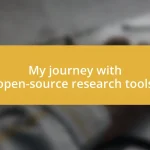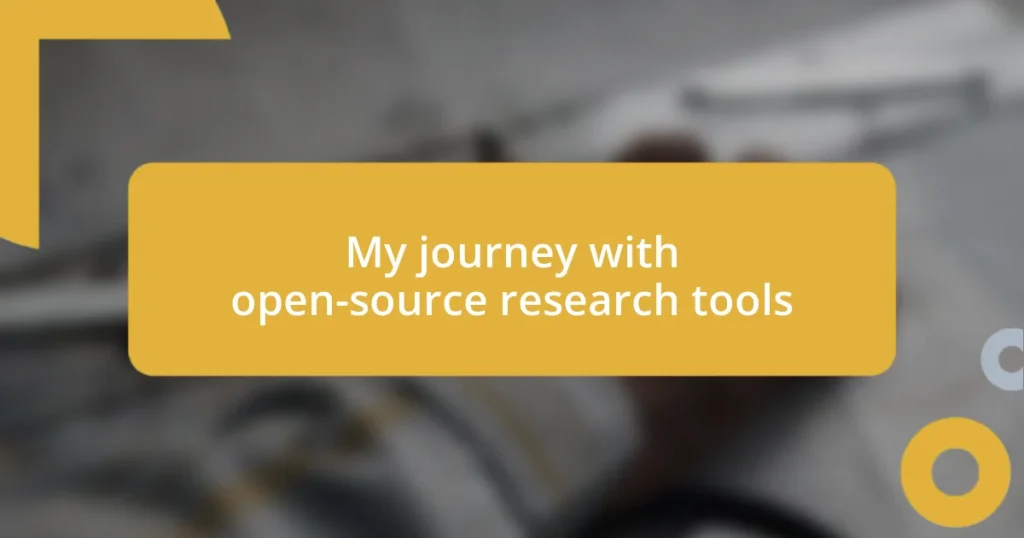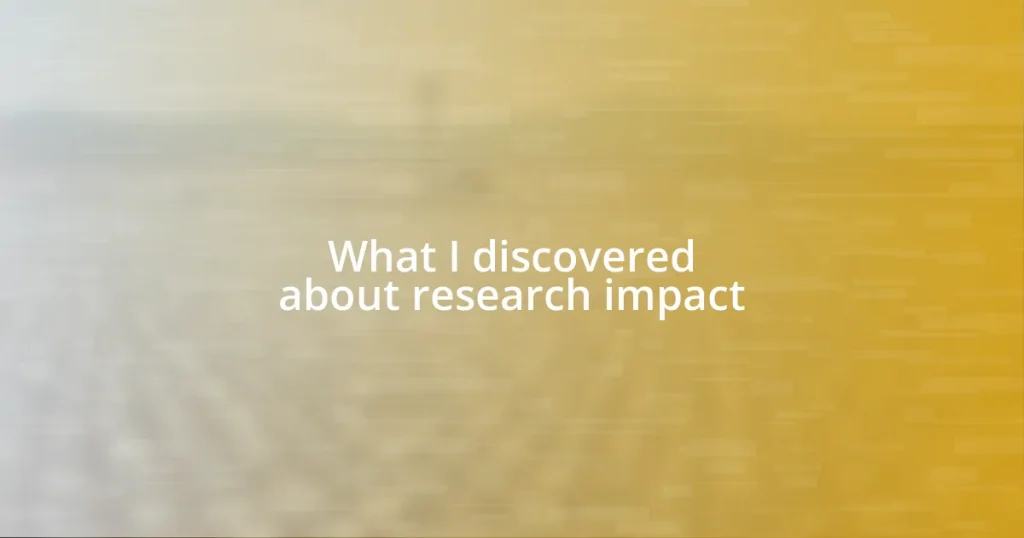Key takeaways:
- Open-source research tools are flexible, cost-effective, and foster collaboration, enabling researchers to customize solutions to fit their unique needs.
- Key features include user-friendly interfaces, robust customization options, and collaborative capabilities, which enhance usability and community engagement.
- Engagement with user communities and maintaining flexibility in tool selection are essential best practices for overcoming challenges and maximizing the benefits of open-source tools.
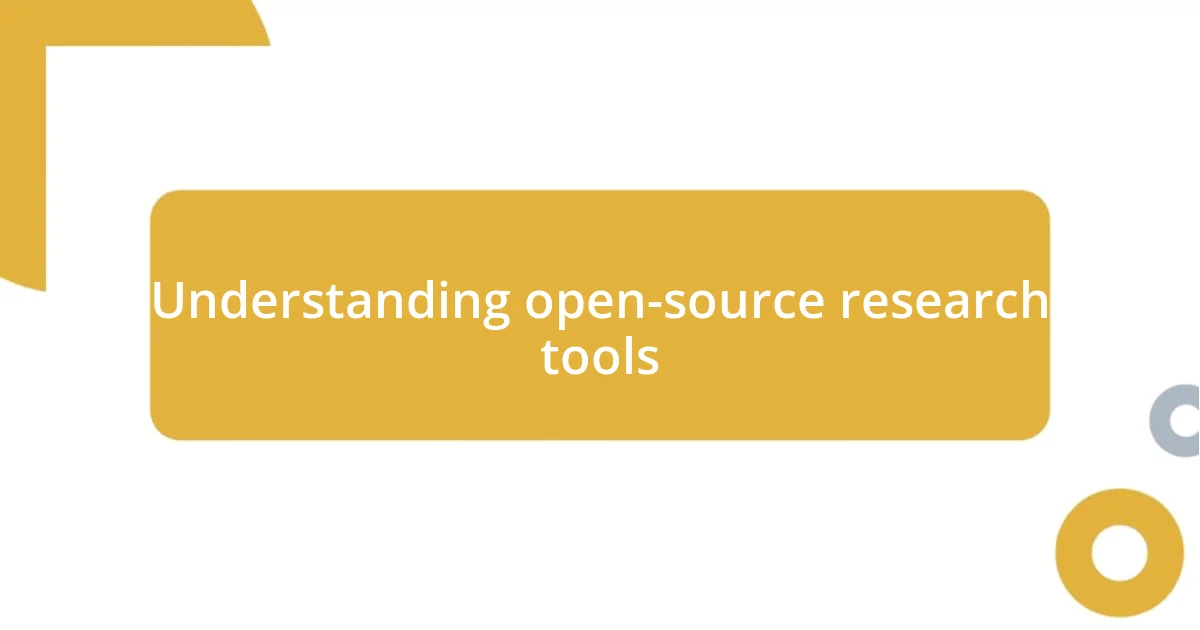
Understanding open-source research tools
Open-source research tools are software programs whose source code is freely available for modification and distribution. I remember the first time I dived into using an open-source tool; it felt like stepping into a vibrant community where everyone shared knowledge and resources. Have you ever felt the thrill of exploring something that feels alive and ever-evolving? That’s exactly the energy I found in open-source platforms.
One of the best things about these tools is their adaptability. For instance, last year, I was working on a project that required specific data analysis features that commercial software just didn’t provide. I stumbled upon a powerful open-source solution that not only fit my needs but was also customizable. Hasn’t everyone faced moments when they had to compromise because of limitations? I felt empowered as I tinkered with the code, adapting it to suit my unique requirements.
Moreover, open-source research tools foster collaboration and innovation. In a recent team project, we leveraged an open-source database tool to streamline our workflow. Collaborating with my colleagues was a revelation, making me realize that sharing ideas leads to breakthroughs we might have never reached alone. Isn’t it fascinating how open-source projects thrive on diversity and collective contributions? That’s the magic at work, turning individual insights into powerful solutions for the community.
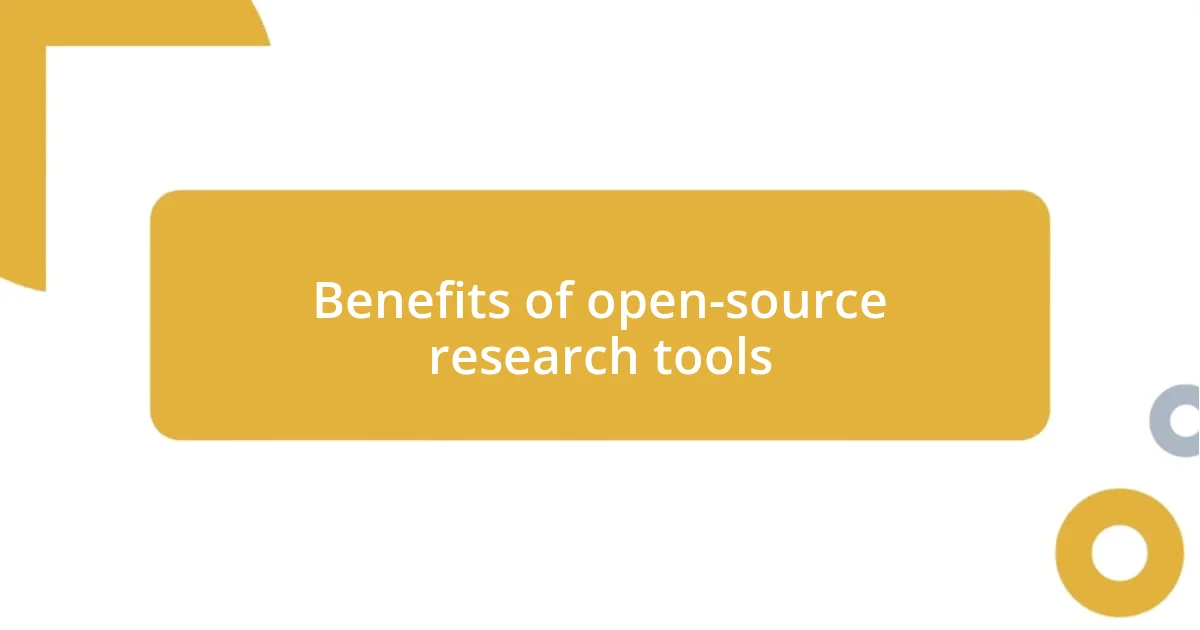
Benefits of open-source research tools
The benefits of open-source research tools are numerous and often transformative. For me, one standout advantage is the cost-effectiveness. While working on a grant-funded project, I realized that switching to an open-source alternative saved us thousands of dollars. I recall the sigh of relief from my team when we discovered that we could achieve our goals without hefty software licenses. It felt like a small victory that allowed us to allocate funds to other crucial aspects of our research.
Another key benefit lies in the extensive community support that often accompanies these tools. When I encountered a tricky problem with one of the software applications, I turned to the open-source community forums. To my surprise, not only did I find multiple solutions, but I also felt a sense of camaraderie. Here’s a quick list of benefits I’ve encountered firsthand:
- Cost-Effective: Significant savings on software licenses.
- Customization: Flexibility to modify tools according to specific project needs.
- Community Support: Access to a network of users willing to share solutions and insights.
- Continuous Improvement: Regular updates and enhancements driven by user contributions.
- Transparency: Clear visibility into the software’s functionality and operations.
Each of these benefits reinforces why I firmly believe that open-source research tools can be a game-changer in any research journey.
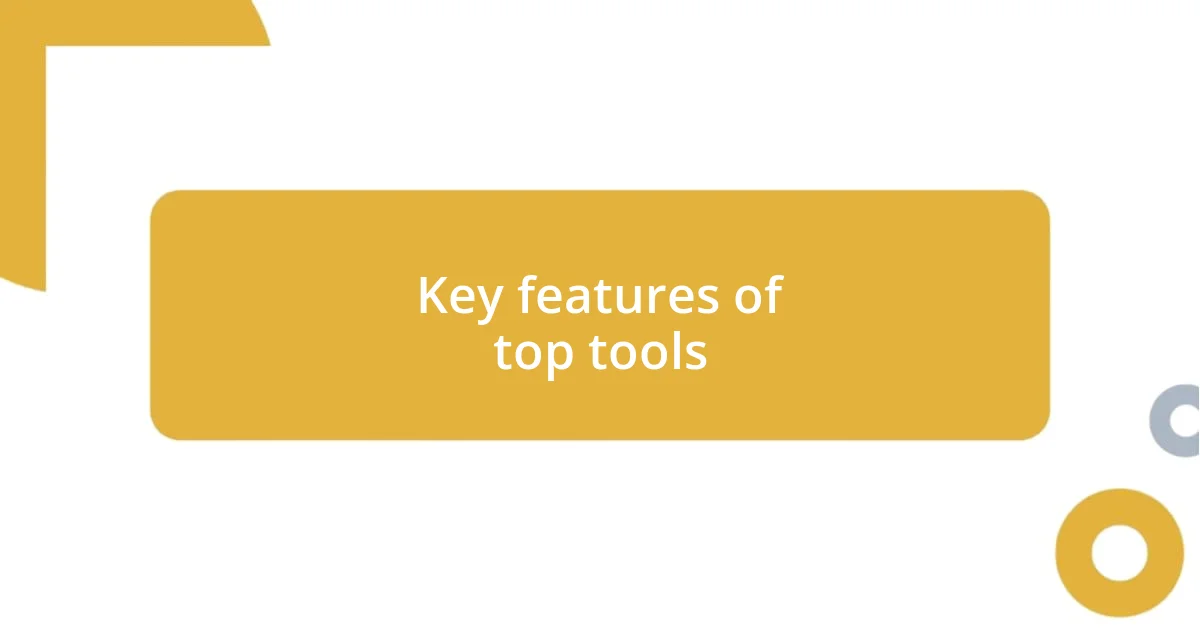
Key features of top tools
The key features of top open-source research tools are something I’ve explored extensively in my journey. One standout characteristic is their user-friendly interfaces. I remember the first time I downloaded a particular tool; its layout was so intuitive that I found myself navigating it effortlessly. Isn’t it refreshing when technology doesn’t feel daunting but rather inviting? This usability encourages even those who are less tech-savvy to dive in and leverage powerful capabilities without a steep learning curve.
Another vital feature comes from the robust customization options available. During a particularly challenging project, I had to adjust an analysis tool to include unique data metrics. I remember spending hours tweaking the code, but the satisfaction I felt when my adjustments worked perfectly was immense. Can’t you relate to that feeling of triumph when you create something that fits your specific needs? These customization abilities allow researchers to tailor the tools they use to better serve their purposes.
Finally, the collaborative attributes of these tools cannot be overstated. I often collaborated with other researchers using an open-source platform that allowed real-time sharing of data and insights. Just last month, I was part of a stimulating brainstorming session where we all accessed the same live document, making the experience feel charged with creativity. Is there anything more exhilarating than watching ideas flow in real-time, knowing everyone’s contribution creates something bigger than any one of us could achieve alone?
| Feature | Description |
|---|---|
| User-Friendly Interface | Intuitive navigation and accessibility for all users. |
| Customizable | Ability to modify tools to fit specific research needs. |
| Collaborative | Supports real-time sharing and input from multiple users. |
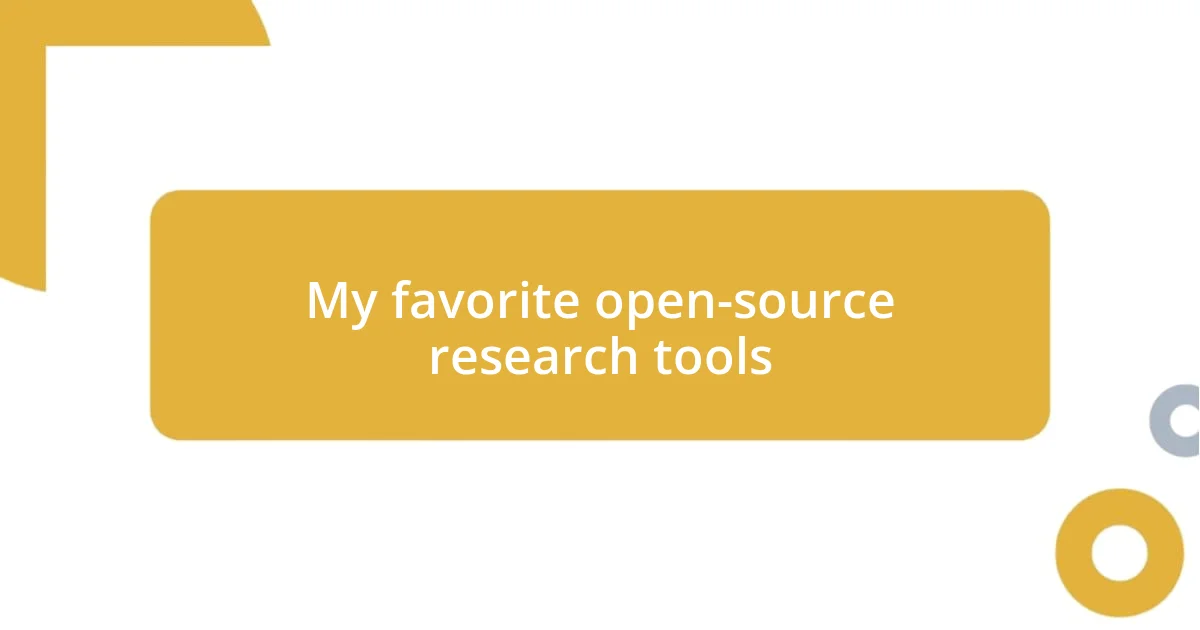
My favorite open-source research tools
One of my all-time favorite open-source research tools is Zotero. This tool has become my go-to for managing citations and organizing research materials. I remember the first time I used it for a paper; the sense of relief was palpable when it effortlessly generated my bibliography. Have you ever wished for a magic wand to organize your references? Trust me, Zotero feels almost like that wand in the chaotic world of academic writing.
Another tool that I’ve found incredibly useful is R. As someone who often dives into data analysis, I appreciate how R combines statistical prowess with flexibility. What stands out for me is the vast array of packages available, allowing me to extend its functionality based on project needs. There was this time when I needed to visualize complex data trends, and after exploring a few packages, I discovered ggplot2. The moment I saw my data come to life in a beautifully crafted graph, I couldn’t help but marvel at the power of open-source tools. Doesn’t it feel rewarding when you can visualize your hard work so effectively?
Finally, I can’t overlook the power of Jupyter Notebooks in my research toolkit. This tool has transformed how I document my analyses and share findings. I distinctly remember collaborating with colleagues on a project; we used Jupyter to present our results in an interactive format. The thrill of seeing them engage with the data firsthand, making their own observations, was palpable. Isn’t it inspiring when technology allows for such dynamic collaboration? These experiences have solidified my appreciation for open-source tools and their role in enhancing research productivity and collaboration.
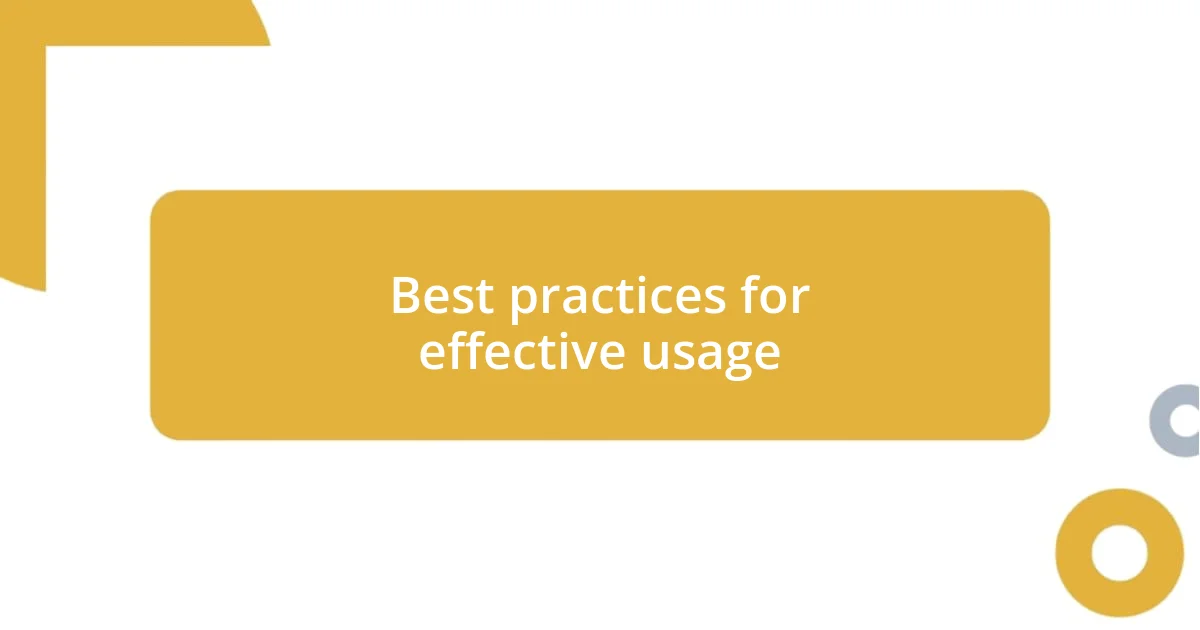
Best practices for effective usage
To get the most out of open-source research tools, it really helps to invest some time in understanding their functionalities. I remember when I first started using these tools; I spent a Sunday afternoon watching tutorials and reading documentation. It might seem daunting initially, but isn’t it amazing how much confidence you gain just from a bit of exploration? This knowledge pays off as you discover shortcuts and advanced features that can drastically improve your workflow.
Another best practice I’ve embraced is engaging with communities surrounding these tools. I’ve sought out forums and social media groups where users share tips and troubleshooting advice. Just a few weeks back, I posted a query about a specific feature I was struggling with, and the responses flooded in! It felt like having an entire team of experts ready to support me. Have you ever felt that sense of camaraderie with strangers brought together by a common interest? It’s a reminder of how open-source projects encourage collaboration and sharing, enhancing our research experiences.
Lastly, maintaining flexibility in your approach is crucial. I once entered a project certain about using a specific tool, only to realize halfway through that another open-source option could do the job more efficiently. Embracing that pivot was not only enlightening but also revitalized my enthusiasm for the project. It’s empowering to understand that the tools are interchangeable; aren’t we lucky to have such a diverse ecosystem at our fingertips? Adopting a mindset of adaptation can lead to discovering hidden gems within the vast world of open-source research tools.
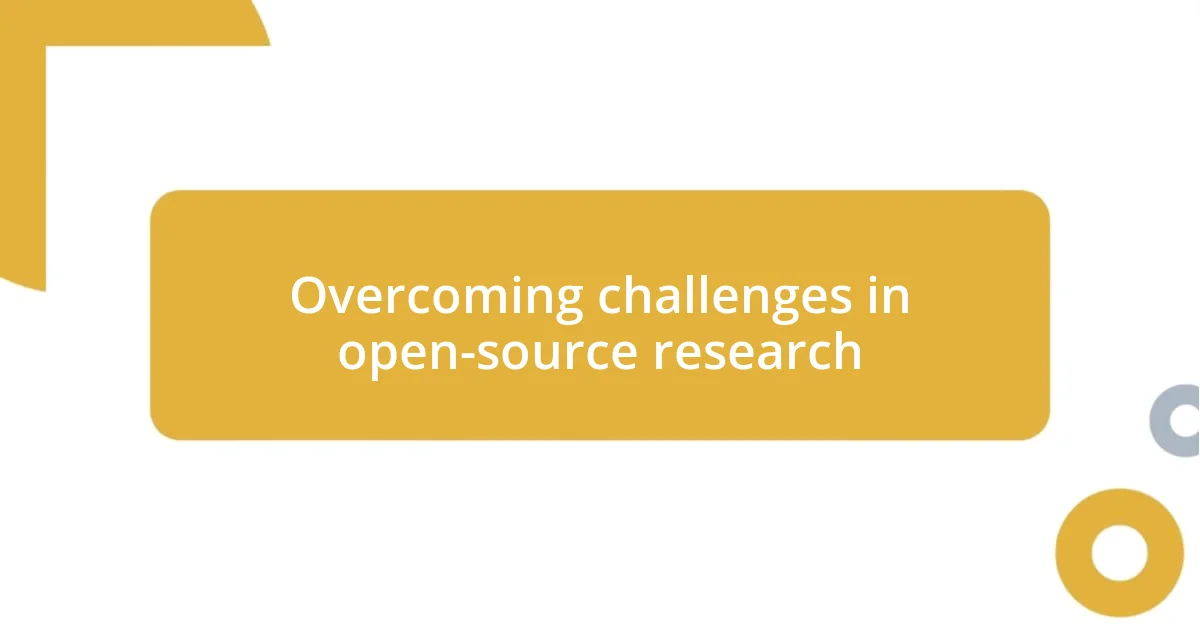
Overcoming challenges in open-source research
One significant challenge I faced while navigating open-source research tools was the learning curve associated with them. I vividly recall the confusion I felt trying to piece together various functions in a software I was excited about. It made me ask, “Why is this so complicated?” Yet, I discovered that persistence really pays off. Once I overcame that initial hurdle, I felt a profound sense of accomplishment. It’s a journey worth taking, don’t you think?
Another hurdle came from the varying documentation quality of different tools. There were instances when I ventured into a tool only to find sparse guides that left me scratching my head. I remember a late night trying to figure out a specific library in R; it felt like deciphering an ancient code! But here’s where tapping into user communities became invaluable. I learned that reaching out for help isn’t a sign of weakness but an essential part of the research process. How many times have you felt stuck and wished for a guiding hand?
Finally, I’ve had my share of compatibility issues between different tools, especially when integrating data sources. There was one project where my data didn’t sync well with my visualization tool, leading to hours of frustration. I found myself asking, “Why can’t it just work seamlessly?” It taught me the importance of planning my workflow. By ensuring compatibility upfront, I saved myself not just time but also a lot of headaches. Isn’t it fascinating how a little foresight can transform challenges into remarkably smooth processes?





